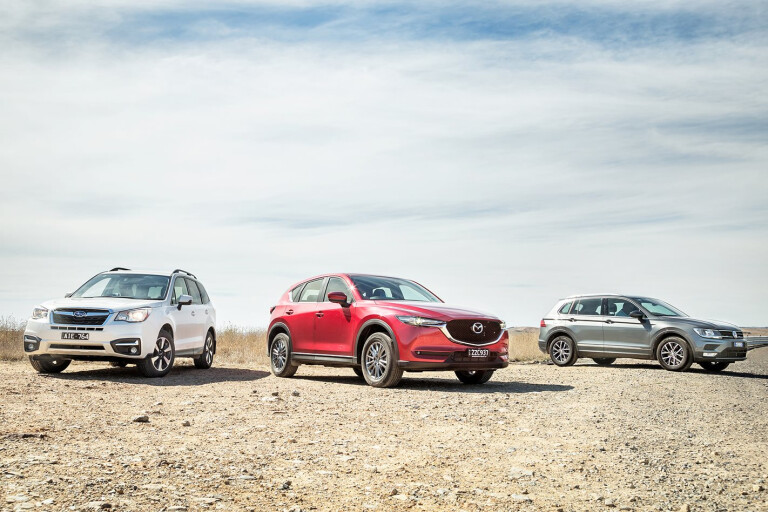
It shouldn’t be that difficult: creating a mid-sized SUV that does what all families expect and still presses dynamic buttons along the way.
But somehow the quest to take a slice of the most popular segment of the fastest growing vehicle type in the country has delivered carparks full of mediocrity - for years.
It’s especially pertinent when you look at the fantastic options on offer in the family sedan and wagon market: Volkswagen Passat or Mazda 6 anyone?
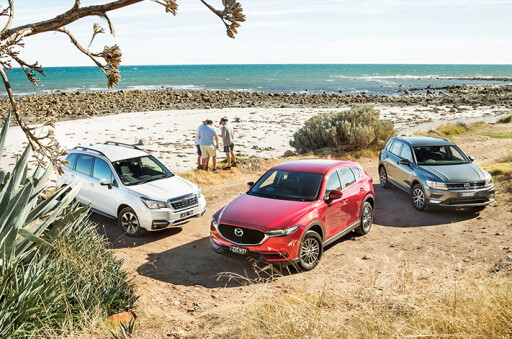
Then there’s Holden’s locally-made Commodore, a car with only months to live. The dramatic drop in sales of medium and large sedans certainly has nothing to do with their breadth of ability.
But things are changing. The second generation Volkswagen Tiguan that arrived in 2016 ushered in a more resounding blend of handling, functionality and value.
More recently Mazda’s second generation CX-5 has addressed niggles of the original to create a tempting mid-sized package.
But which is best, which medium SUV stands out?

That question brings us to the Fleurieu Peninsula south of Adelaide with a trio of the country’s best mid-size SUVs.
The CX-5 and Tiguan go head-to-head against the trusty Subaru Forester, a long-lived and perennial favourite in a market segment that bounces from strength to strength.
While the temptation is to go for the sales sweet spot of the segment – front-drivers with petrol engines – we’ve got bigger plans to address that end of the market soon.
So, for this test we’ve opted for the top shelf; diesel engines powering all four wheels.
MAZDA CX-5 TOURING
Playing it safe is a phrase that springs to mind with Mazda’s new CX-5. Looking like a condensed version of the CX-9, the new model doesn’t stray far from a successful formula, right down to leveraging many of the underpinnings of the previous model, a car that bowed out as the top selling SUV in Australia.
But just a couple of minutes behind the wheel show the CX-5 has leapt further than it may appear in the brochure.
The fact we were discussing the Mazda’s refinement as being on a par – or better than – its rivals is evidence of how much the CX-5 has improved.
The original CX-5 steered and rode well, but it suffered from a common Mazda trait: road noise.
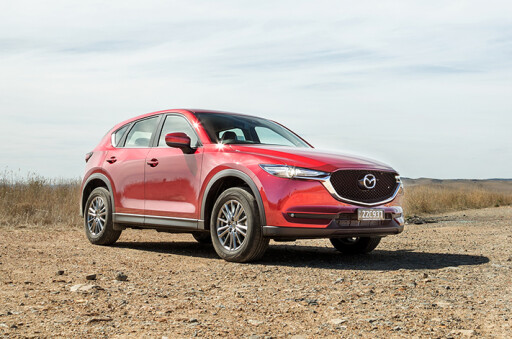
The new model has plumped up by 40kg – in part due to additional sound deadening – and the result catapults it up the ranks to be among the quietest of its peers.
That maturity stretches to its dynamics, which meld impressive ride comfort with control and competency.
Steering isn’t as direct or communicative as the Tiguan’s, which makes mid-corner adjustments less precise, but it’s alert enough to allow the chassis to shine and create one of the more enticing mid-sizers once the pace ramps up.
That it blends dynamic aptitude with a beautifully controlled body is the CX-5’s masterstroke.
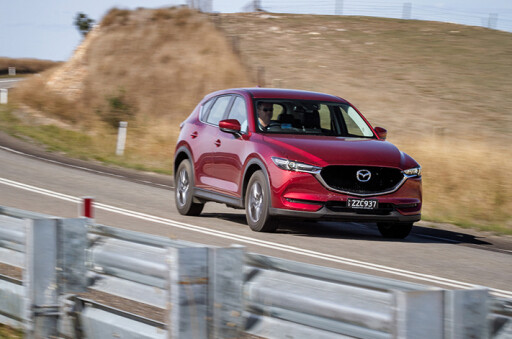
With more suspension travel than the Tiguan, the Macpherson strut front and multi-link rear is supple yet quick to recount after big lumps.
But it’s the engine that is the standout single element of the CX-5. The Mazda puts cubic capacity to good effect, its 2.2 litres 10 percent larger than its rivals. The four-cylinder turbo manages 129kW and, in a twist for a diesel, it doesn’t mind a rev, spinning out to 5000rpm with little complaint.
But it’s the hearty 420Nm that quickly swells beneath your right hoof that makes the Mazda a clear winner among its peers, comfortably outpacing the Tiguan and Forester in our 0-100km/h testing. The 8.7-second time is impressive for a mainstream diesel.
Elsewhere the CX-5 dishes up incremental improvements. Elegant metal finishes complement the blacks and greys inside. The 7.0-inch partial touchscreen (it stops being a touchscreen once you’re moving, instead directing you to the iDrive-style central control knob) protrudes from the dash while a logically laid out centre stack teams dials with buttons for excellent ergonomics.
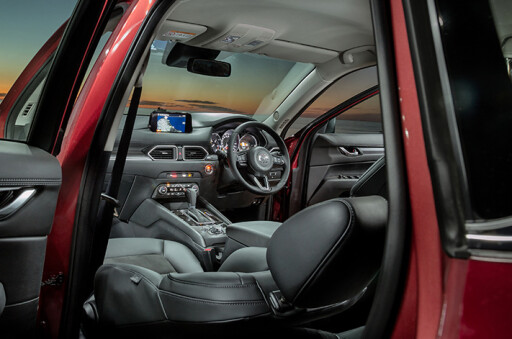
Our Touring model – the newcomer wedged into the middle of the five-model line-up – also brings value for its $41,990 spend.
While it’s missing temperature controls in the rear, the addition of air vents and a fan control improve comfort.
Fake leather upholstery is less endearing, although elsewhere the cabin uses quality finishes to good effect.
There’s also parking sensors at either end, DAB digital radio, sat-nav, smart key entry, auto wipers and lights, and a head-up display.
Active safety is class leading, upping the threshold of the auto braking to 80km/h, more than double that of the VW. It also brakes automatically in reverse and monitors blind spots on the run.
Plenty for your money, then.
SPECS
Model: Mazda CX-5 Touring diesel
Price as tested: $41,990
NCAP rating: Not tested
Engine: 2191cc dohc, 16V turbo diesel
Max power: 129kW @ 4500rpm
Max torque: 420Nm @ 2000rpm
Transmission: 6-speed auto, AWD
Kerb weight: 1744kg
Fuel economy: 6.0L/100km
0-20km/h: 0.9
0-40km/h: 2.1
0-60km/h: 3.9
0-80km/h: 6.0
0-100km/h: 8.7
Plus: Strong diesel engine; body control and ride; active safety
Minus: Diesel misses transmission sport mode; steering could benefit from additional sharpness
Verdict: 8.0
VOLKSWAGEN TIGUAN 110TDI COMFORTLINE
Volkswagen doesn’t shy away from the fact its Tiguan carries a price premium.
“We’ll never be the cheapest car in the market,” said Volkswagen Australia chief Michael Bartsch last year in discussing the “premium for the people” positioning of cars such as the Tiguan.
But the $42,990 for the all-paw 110TDI also brings plenty of gear for the money. Auto city braking and lane assist with mild steering assist are included, as are parking sensors at either end and three-zone air-conditioning, allowing those in the rear to dial up their own micro-climate.
Beyond the raw lists is restrained style that oozes quality. The seat material is rugged yet welcoming and elegant, the sensible use of classy metal finishes inside lifts the ambience of the dark plastics that dominate.
The genius of the Tiguan comes the more you push and poke things around the cabin.
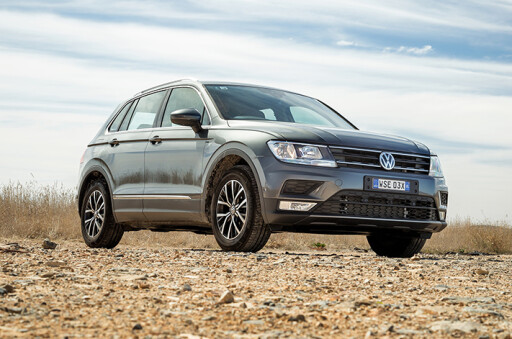
The rear seats slide forward and back, allowing a trade-off between boot space and legroom.
Storage is masterful, from the binnacle atop the dash to sizeable overhead storage bins and even bottle holders either side of the back seats.
Those back seats are perched fractionally higher than those in the CX-5, combining with large windows for excellent forward and side vision, a boon for smaller people.
But options can add up. The fancy digital dashboard of our car pairs with additional cameras and radar cruise control for another $2250, and if you don’t want a white one it’s another $700 (most Mazda colours and all of the Foresters are no cost options).
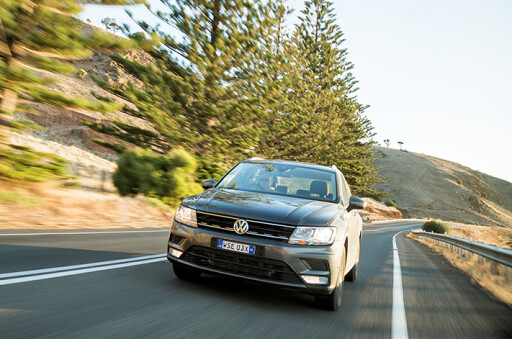
Like all of the cars here it’s running on 17-inch alloys, but the Tiguan’s 215mm tyres are the narrowest here – by just 10mm.
However, the Tiguan’s Michelins hang on better than the Yokohamas on its Japanese rivals.
Teamed with a clear dynamic focus it makes for the most car-like handling we’ve experienced in a mid-sized SUV.
Weighty steering – which loads up further in Sport mode – encourages you to dive deeper into bends, negating the need to wash off speed then build it up again.
It’s not just brisk, it’s also fun; a car you’d happily punt along a backroad once the kids are tucked up in bed.
However, that cornering nous comes at the expense of the ride, which is spoiled by low speed sharpness and left-right jiggling once travelling faster. It’s not bad, but it’s outclassed by the supreme control of the Mazda.

The Tiguan’s drivetrain also loses some points.
The 2.0-litre four-pot muscles up a stout 340Nm, the least of our trio. Its 110kW also lags the CX-5 by 19kW.
Those lower figures have less to deal with, though; at 1647kg the Tiguan is almost 100kg lighter than the Mazda.
So it’s brawny enough once up and running and the seven-speed transmission slips swiftly between ratios.
But from a standstill the Tiguan can stutter, making it difficult to time a hard launch and leading to the occasionally inconsistent take-off.
Yet there are efficiency benefits and the Tiguan’s claimed 5.9L/100km consumption is a leader in this trio.
SPECS
Model: Volkswagen Tiguan 110TDI
Price as tested: $42,990
NCAP rating: 5 stars (ANCAP)
Engine: 1968cc dohc, 16v turbo diesel
Max power: 110kW @ 3500-4000rpm
Max torque: 340Nm @ 1750-3000rpm
Transmission: 7-speed twin-clutch auto
Kerb weight: 1647kg
Fuel economy: 5.9L/100km
0-20km/h: 1.4
0-40km/h: 3.0
0-60km/h: 4.9
0-80km/h: 7.4
0-100km/h: 11.0
Plus: Dynamic class; clever interior packaging; frugal diesel
Minus: Price premium; occasionally jiggly ride
Verdict: 7.5
SUBARU FORESTER 2.0D-L
The Forester is in some ways the elder statesman of the mid-sized SUV class. Not only is the nameplate about to blow out 18 candles on the birthday cake, but the current generation has enjoyed more than four years of service.
In a market segment moving as quickly as it is the loveable Subie is on the back wheels from the outset.
But it comes out fighting on value. Our 2.0D-L is a $35,740 proposition when paired with the auto transmission, undercutting its rivals by about $6000.
For that you get the basics, such as a reversing camera and 7.0-inch touchscreen. It’s also the only one to get shift paddles for some additional gearshift control.

The leather-clad 2.0D-S would have been better matched in this company; at $41,740 it picks up heated mirrors, a sunroof, 18-inch alloys, fog lights, self-levelling LED headlights with cornering function, auto wipers, smart key entry and heated front seats as well as a powered driver’s seat.
Where the Forester is deficient is with active safety. Subaru’s excellent EyeSight system is missing from the diesel models and there’s no word on when it’s likely to show, so that means no auto braking or blind spot warning.
Venture into the rear and there are shortcuts, such as the lack of rear air vents. The 60/40 rear seat also misses the 40/20/40 folding flexibility of the others.
But there’s space aplenty, especially head room and knee room in the rear.
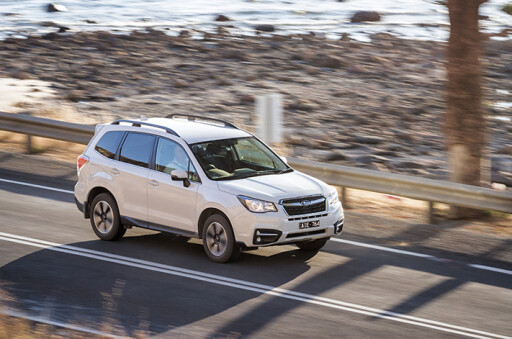
Up front, the seats are the plushest of the lot, although they could do with more support to control sideways movement, something noticeable once bumps enter the equation.
The Forester is not a serious off-roader, but in this company it’s borderline bush-basher.
Its bumpers are further tucked out of the way and its underbody is 220mm off the deck, some 20mm more than its rivals.
It’s also the only one with a full-sized spare, allowing for bigger adventures and the lure of a proper replacement in the event of a puncture.
But the Yokohama Geolandars appear to have been chosen partly for their off-road cred. On-road, the Forester reaches its limits sooner than its rivals, yelping for mercy in the process.

That higher ride height, too, combines with greater suspension travel to result in more leaning through bends. Ultimately its body movements aren’t as well controlled as its rivals, and there’s no meaningful payoff in comfort.
With 108kW the four-pot diesel is the least powerful here – just – although its 350Nm is a healthy counterpoint; the fact that peak arrives as low as 1600rpm adds to its usefulness.
But it’s the CVT auto that saves the day for the Forester. It occasionally feels undernourished, but the ability of the transmission to plonk the engine bang in its sweet spot when accelerating ensures swift responses and a willingness that belies the numbers.
There’s no stop-start with the engine, though, something that hurts its official fuel number. The claimed 6.4L/100km for the auto isn’t bad, but it’s outclassed in this company.
Ultimately its age that is wearying what is a popular warrior.
SPECS
Model: Subaru Forest 2.0D-L
Price as tested: $35,740 (auto)
NCAP rating: 5 stars (ANCAP)
Engine: 1998cc dohc, 16v turbo diesel
Max power: 108kW @ 3600rpm
Max torque: 350Nm @ 1600-2400rpm
Transmission: CVT auto
Kerb weight: 1698kg (2.0D-S is 1729kg)
Fuel economy: 6.4L/100km
0-20km/h: 1.1
0-40km/h: 2.5
0-60km/h: 4.4
0-80km/h: 7.1
0-100km/h: 10.7
Plus: Spacious interior; value; it can actually be used as an off-roader
Minus: Equipment deficiencies; dated interior; tyre grip and dynamics
Verdict: 6.5
VERDICT
Time is often an enemy of cars and that’s certainly the case with the Forester, which is showing its age against fresh competition.
Willing and well sorted drivetrain aside, the scarcity of active safety aids in the diesel models and dynamics that slot into third place in this company sap valuable points.
The Forester’s spacious cabin and off-road talent aren’t enough to push it beyond its peers.
Its biggest appeal is a price tag that undercuts its rivals, but once lined up side by side the Forester is still outclassed.
Which leaves a hard-fought tussle for the top between the Tiguan and the CX-5.
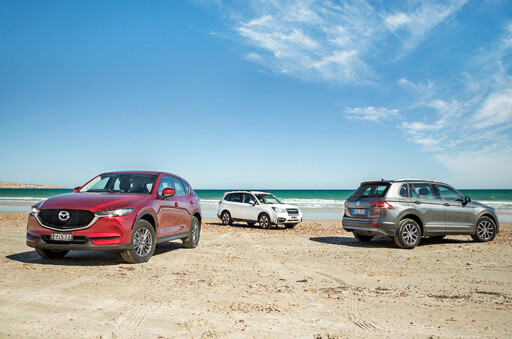
The Tiguan’s crisp steering and athletic chassis earns it big marks, especially for those who enjoy a spirited drive. And a new level of cleverness for the interior is a win for what is a talented car.
But the Tiguan is the most expensive here; it’s good value but not fantastic.
And bumps ultimately undo some of the Tiguan’s poise.
Or, more to the point, they highlight the efforts gone into blending comfort and control with the CX-5.
Throw in a class leading engine and an elegant interior as well as plenty of toys and it makes the CX-5 a deserved winner.
For now.
Mid-sized SUVs have never been as competitive as they are today.

COMMENTS